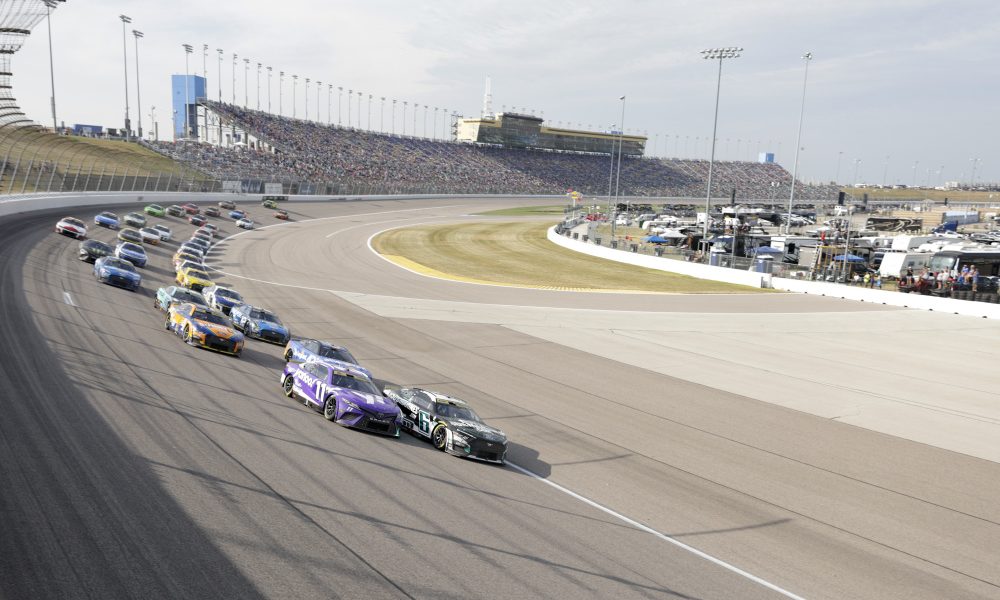In the fall of 2001, under a sunny Midwestern sky, a new racetrack hosted its first NASCAR Cup Series race.
Kansas Speedway is a 1.5-mile paved tri-oval racetrack sitting on over 1,200 acres just west of downtown Kansas City (Missouri) off the 70 and 435 interstates. It is a classic cookie-cutter intermediate, and if its aerial shot were overlaid with Las Vegas Motor Speedway or the now-defunct Chicagoland Speedway (the track names and logos absent), it would probably take a minute to tell them apart.
In that regard, there is nothing special about Kansas. It has variable banking through the tri-oval and corners, and the backstretch seems almost flat. It’s a cliché, but if you’ve seen one intermediate, you’ve seen them all.
Kansas Speedway deserves to be showered with sunflowers, however. Somewhere along the way in the last 23 years, Kansas has separated itself from its sister tracks and it’s become a must-watch event as a bit of a wild card in the postseason.
As the surface continues to age, the racing has become some of the best in the series. It can be a slick track, it’s fast, and drivers have spoken fondly of it more and more. It’s become a favorite because of the options drivers have with multiple lanes and ways to be successful, and with speed found by running around the wall, it leaves no margin for error.
“I love this race track,” Christopher Bell said after winning the pole last weekend. “I love qualifying here too. It’s so much fun to be able to drive as hard as you can, put it right up against the wall and see what she’s got.”
Kansas is no gimmie race. It’s not uncommon to see a driver lose control and go for a spin. Or, as Sunday showed, it’s not uncommon to be punished with a blown tire (even from the race lead) through bad luck (punctures) or taking a risk on air pressure or setup. Kansas can KO a driver’s chance at a victory or a championship.
NBC Sports shared a graphic late on Sunday reminding viewers of that fact, showing the number of playoff drivers who have experienced trouble in a Kansas playoff race dating back to 2017. At the time, nine drivers had had issues, then Chris Buescher became the 10th when he blew a tire with seven laps to go.
What is important to keep in mind is that where Kansas has fallen in the postseason has changed over the years: the second race in the first round for the last two years, the second race in the third round in 2021, the first race in the third round in 2020, the elimination race in the second round in 2019, 2018, and 2017.
The number of playoff drivers who have experienced issues in Kansas playoff races in those years: nine of 16 drivers in 2022 (56%), four of eight in 2021 and 2020 (50%), eight of 12 in 2019 (67%), six of 12 in 2018 (50%), and 10 of 12 in 2017 (83%).
“I think this particular racetrack has just been racey in general,” Kevin Harvick said. “I think when they redid the racetrack with the progressive banking and the way that the groove has moved around – you can run the middle, top or bottom – it gives you a lot of options from a driver standpoint. I think that’s just a product of the racetrack. I don’t think it has anything to do with one car or the other.
“I think that the other thing that happens here is on the restarts. You have so much room to go into Turn 1 and 2 and go all over the racetrack and look for empty space to try and make a move. You can be super aggressive with the pushing. I think that usually causes the issues that happen on the restarts – just everyone being aggressive because you know that you have to go and do what you have to do and take chances in order to put yourself in the position to be in a good spot.”
Heaping praise on an intermediate racetrack might seem unusual. It’s also unusual for a place like Kansas Speedway to go from ordinary to deserving of its two dates on the schedule and, furthermore, of keeping its place in the postseason for the foreseeable future.
